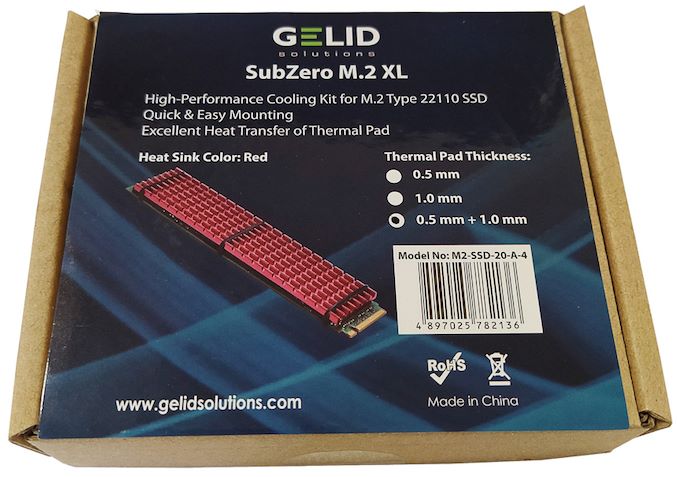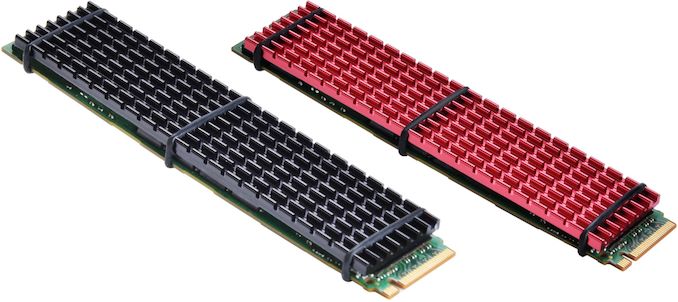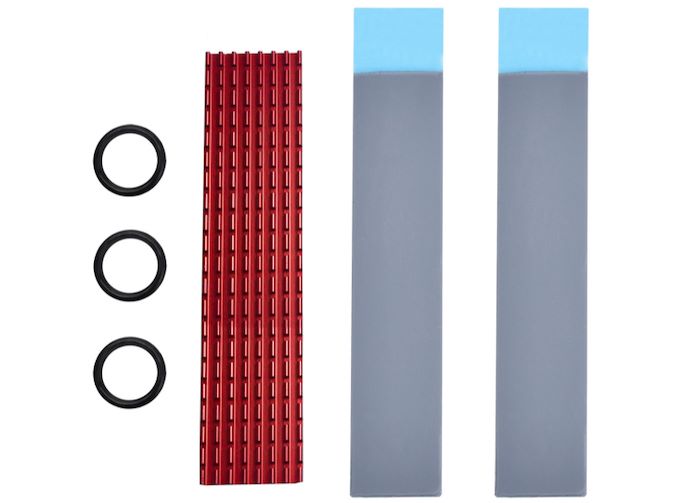GELID Unveils SubZero M.2 XL: A DIY Cooling System for M.2-22110 SSDs
by Anton Shilov on December 3, 2019 6:00 PM EST- Posted in
- SSDs
- Cases/Cooling/PSUs
- M.2
- Optane 905P
- Gelid
- M.2-22110

GELID has introduced a rather unusual product: an aftermarket heatsink designed for SSDs that use the server/workstation-oriented M.2-22110 form-factor. The SubZero M.2 XL aluminum heatsink is shipped with two thermal pads as well as silicone fixtures and is designed to keep these drives from overheating and and performing more consistently under high loads
The majority of client SSDs these days use an M.2-2280 form-factor, as this is the largest drive that most desktops and virtually all notebooks can accommodate. By contrast, M.2-22110 drives are somewhat more common for server/workstation-grade drives, as those systems have more space and there's a need for features such as power loss protection. Nonetheless, there's still some overlap with enthusiast-class desktop boards, which can include an M.2-22110 slot or two just in case.
At present, the best-known client M.2-22110 SSD is Intel’s Optane 905P M.2, which uses 3D XPoint memory and is among the highest performing drives available today. Not so coincidentally, the Optane 905P M.2 is also known for thermal throttling under high loads if the drive is left bare. So for 905Ps that didn't come with a heatsink, GELID’s SubZero M.2 XL fills a specific niche.
| GELID's SubZero XL for M.2-22110 SSDs | |||
| HS-M2-SSD-20 | |||
| Heatsink Dimensions | 100 х 20 х 3 mm | ||
| Heatsink Material | Aluminum | ||
| Thermal Pad Thickness | 0.5 & 1 mm | ||
| Thermal Pad Conductivity | 12 W/mK | ||
| Thermal Pad Hardness | 35 Shore | ||
| Weight | 45 grams | ||
| Bundle | Heatsink x1 Thermal Pad x2 Fixtures x3 |
||
GELID’s SubZero M.2 XL heatsinks are available in black and red for an MSRP of $10/€9.
Related Reading:
- EKWB Begins Selling Heatsink for Intel’s Optane 905P M.2 SSD
- The Enterpise TLC Storage Era Begins: Rounding Up 13 SSDs With Samsung, Intel, and Memblaze
- Intel Expands Optane 905P SSDs To 1.5TB
Source: GELID












16 Comments
View All Comments
yetanotherhuman - Wednesday, December 4, 2019 - link
Maybe we should have gone with 1.8" SSDs instead, with a 12Gbps SAS connection. I vote for that. All aluminium housing with thermal pads..edzieba - Wednesday, December 4, 2019 - link
The 'need' for cooling m.2 drives is massively overblown. Even in benchmark testing, it takes several tens to hundreds of GB of continuous writing for a controller to start throttling.If you're buying them for cosmetics like RAMsinks then knock yourself out, but in terms of function they are about as useful as ramsinks.
Billy Tallis - Wednesday, December 4, 2019 - link
The cooling and PCB space limitations are a non-issue because they only come into play when you're far past the practical cost limitations, or if you're just trying to get the highest benchmark scores without regard to real-world use cases. M.2 is fine for consumer systems, and the form factor is certainly not holding back the progress of consumer storage tech in any meaningful way.Soulkeeper - Wednesday, December 4, 2019 - link
aluminum passive heatsinks make next to no difference ...Unless it's copper with some very thin fins, I don't see the point.
Spunjji - Wednesday, December 4, 2019 - link
They don't need to make a huge difference - 10 degrees is enough to stop most of these drives from throttling, and 15-20 should have a beneficial effect on service life.Copper would change that by around 5 degrees at most.
Eliadbu - Monday, December 9, 2019 - link
interesting, I have similar solution from EKWB which looks to have better mounting solution but it's also bit more expensive I wonder how they compare.